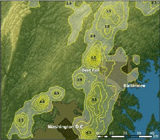
« PREVIOUS ENTRY
I see dead blogs

Two weeks ago, we got drowned here in New York when a flash storm dumped three inches of rain on the city. It doesn’t sound like much, but considering that about 13 million gallons of water flood into the subway on a completely bone-dry sunny day, the additional gallons totally b0rked the system — and the trains ground to a halt, which meant New York ground to a halt.
So I was intrigued to happen upon a recent study claiming that cities actually increase the intensity of storms. Two Princeton engineers gathered a boatload of data about a humongous storm that slammed Baltimore in July 2004, looking at lightning strikes, rainfall, clouds and aerosols. Their conclusion? The structure of the city exacerbated the storm — producing 30 per cent more rainfall than had the storm passed over a piece of nearby non-urban countryside. As they noted in a press release:
Much of the lightning during the 2004 storm wrapped around the western edges of Baltimore and Washington, D.C., to the south. “It’s as if all of a sudden the lightning can ‘feel’ the city.”
Sentient thunderstorms. I love it. Run for your lives!!
Seriously, though, they hypothesize that there’s a bouquet of urban-design-related vectors at play here, including the “urban heat island effect”, which adds energy to a thunderstorm, as well as tall buildings that increase wind drag and provide “boiling action” that boosts rainfall. Pollution, they think, might also increase the yield.
I'm Clive Thompson, the author of Smarter Than You Think: How Technology is Changing Our Minds for the Better (Penguin Press). You can order the book now at Amazon, Barnes and Noble, Powells, Indiebound, or through your local bookstore! I'm also a contributing writer for the New York Times Magazine and a columnist for Wired magazine. Email is here or ping me via the antiquated form of AOL IM (pomeranian99).

ECHO
Erik Weissengruber
Vespaboy
Terri Senft
Tom Igoe
El Rey Del Art
Morgan Noel
Maura Johnston
Cori Eckert
Heather Gold
Andrew Hearst
Chris Allbritton
Bret Dawson
Michele Tepper
Sharyn November
Gail Jaitin
Barnaby Marshall
Frankly, I'd Rather Not
The Shifted Librarian
Ryan Bigge
Nick Denton
Howard Sherman's Nuggets
Serial Deviant
Ellen McDermott
Jeff Liu
Marc Kelsey
Chris Shieh
Iron Monkey
Diversions
Rob Toole
Donut Rock City
Ross Judson
Idle Words
J-Walk Blog
The Antic Muse
Tribblescape
Little Things
Jeff Heer
Abstract Dynamics
Snark Market
Plastic Bag
Sensory Impact
Incoming Signals
MemeFirst
MemoryCard
Majikthise
Ludonauts
Boing Boing
Slashdot
Atrios
Smart Mobs
Plastic
Ludology.org
The Feature
Gizmodo
game girl
Mindjack
Techdirt Wireless News
Corante Gaming blog
Corante Social Software blog
ECHO
SciTech Daily
Arts and Letters Daily
Textually.org
BlogPulse
Robots.net
Alan Reiter's Wireless Data Weblog
Brad DeLong
Viral Marketing Blog
Gameblogs
Slashdot Games